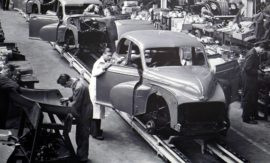Intended learning outcomes: Disclose the combinatorial aspect and the problem of redundant data. Present variants in bills of material and routing sheets as production rules of a knowledge-based system. Explain the use of production rules in order processing.
Generative techniques prove to be appropriate for production with many variants, that is, where there may well be millions of possible variants, but where the entire range of variants can be determined from the start, through a combination of possible values of relatively few parameters. Although each product variant results in a qualitatively different product, all stem from the same product family (see the definition in Section 1.2.2). The production process for all product variants is principally the same. According to Figure 4.4.5.2, product families with many variants are strongly related to the “make-to-order” production environment. According to Figure 4.5.2.1, mass customization is the main production type. See also Figure 7.1.2.1.
Course section 7.3: Subsections and their intended learning outcomes

7.3 Generative Techniques
Intended learning outcomes: Disclose the combinatorial aspect and the problem of redundant data. Present variants in bills of material and routing sheets as production rules of a knowledge-based system. Explain the use of production rules in order processing.

7.3.1 The Combinatorial Aspect and the Problem of Redundant Data
Intended learning outcomes: Present setting the parameters of the fire damper. Disclose the number of possible combinations with n parameters as well as an example for number of identical bill-of-material positions.

7.3.2 Variants in Bills of Material and Routing Sheets: Production Rules of a Knowledge-Based System
Intended learning outcomes: Differentiate between design rules and process rules. Explain the concept of design rules or process rules.

7.3.3 The Use of Production Rules in Order Processing: The Parameterized Bill of Material
Intended learning outcomes: Present an excerpt from the parameterized bill of material for the fire damper.

7.3.3b The Maximum Bill of Material and the Maximum Routing Sheet
Intended learning outcomes: Present the maximum bill of material and maximum routing sheet. Identify data storage complexity for the fire damper example. Disclose the use of generative techniques in connection with CAD and CAM as well as in the service industries.
Course 7: Sections and their intended learning outcomes

Course 7 – The Concept for Product Families and One-of-a-Kind Production
Intended learning outcomes: Produce logistics characteristics of a product variety concept. Explain adaptive and generative techniques in detail. Describe the use of generative and adaptive techniques for engineer-to-order. Differentiate various ways of cooperation between R&D and Engineering in ETO Companies.

7.1 Logistics Characteristics of a Product Variety Concept
Intended learning outcomes: Differentiate between high-variety and low-variety manufacturing. Describe different variant-oriented techniques, and the final assembly schedule.

7.2 Adaptive Techniques
Intended learning outcomes: Explain techniques for standard products with few variants as well as techniques for product families.

7.3 Generative Techniques
Intended learning outcomes: Disclose the combinatorial aspect and the problem of redundant data. Present variants in bills of material and routing sheets as production rules of a knowledge-based system. Explain the use of production rules in order processing.

7.4 Generative and Adaptive Techniques for Engineer-to-Order (ETO)
Intended learning outcomes: Differentiate between the classical procedure and different archetypes of engineer-to-order. Describe the approach for basic and for repeatable engineer-to-order.

7.5 Cooperation between R&D and Engineering in ETO Companies
Intended learning outcomes: Describe different means used for cooperation between the R&D and the order-specific engineering departments. Present the portfolio of cooperation types between R&D and engineering in ETO companies.

7.6 Summary
.

7.7 Keywords
.

7.8 Scenarios and Exercises
Intended learning outcomes: Apply adaptive techniques for product families. Disclose the use of production rules in order processing. Elaborate the setting the parameters of a product family.
